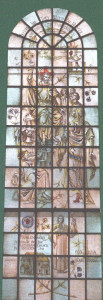Blessed Are They Which Do Hunger and Thirst After Righteousness
The window title consists of one of the Beatitudes, with which Christ’s Sermon on the Mount began. In these words of Jesus, Christians found not only guidelines for daily life, but also an explanation of the relationship between the new concepts related by Christ and the older teachings of Judaism. Inner goodness and integrity, obedience to God and an actively loving relationship with one’s fellowman, make the disciple of Jesus both salt and light in the world (Eph. 5:13-16), as symbolized by the lamp of learning resting on the open Bible at the upper right. The Greek letters Alpha and Omega beneath the arms of the Cross represent our belief that Christ is the beginning and the end.
Henry Melchior Muhlenberg is described in the lower panes as the founder of the Lutheran Church in America, 1742. This does not refer to the present Lutheran Church except in the broad sense. In 1748, however, he did organize the Ministerium of Pennsylvania, the first synodical structure to unite the Lutherans. His motto, Ecclesia Plantanda, means “The Church must be planted.” In the lower left appears the Trappe Church in Pennsylvania, so closely associated with him,
The seal above Muhlenberg’s name was desiged by Martin Luther while teaching at Wittenberg, and it has become the Primary emblem of the Lutheran Church. Comprising it are: the black cross, for faith in Christ crucified; the red heart, for faith in the Saviour; the white rose, to show that faith causes joy, consolation and peace; the blue sky, to denote that such joy of faith in the spirit is the beginning of heavenly joy to come; and the golden ring surrounding all, to signify that such bliss in heaven is endless. The last stanza of the Luther League Hymn (SBH 567) gives a poetic description of this same Luther Emblem.
Back to Window #4 | Forward to Window #6
